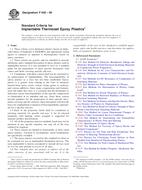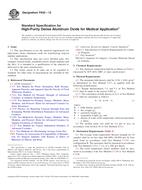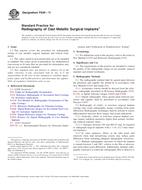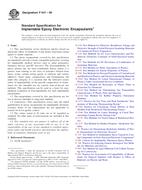Potřebujeme váš souhlas k využití jednotlivých dat, aby se vám mimo jiné mohly ukazovat informace týkající se vašich zájmů. Souhlas udělíte kliknutím na tlačítko „OK“.
ASTM F1635-11
Standard Test Method for in vitro Degradation Testing of Hydrolytically Degradable Polymer Resins and Fabricated Forms for Surgical Implants
Automaticky přeložený název:
Standardní zkušební metoda pro in vitro testování degradaci hydrolyticky polymeru rozložitelného pryskyřic a kovodělných Formy na chirurgických implantátů
NORMA vydána dne 1.3.2011
Informace o normě:
Označení normy: ASTM F1635-11
Poznámka: NEPLATNÁ
Datum vydání normy: 1.3.2011
Kód zboží: NS-50976
Počet stran: 7
Přibližná hmotnost: 21 g (0.05 liber)
Země: Americká technická norma
Kategorie: Technické normy ASTM
Kategorie - podobné normy:
Anotace textu normy ASTM F1635-11 :
Keywords:
absorbable, bioabsorbable, degradation, in vitro, hydrolytically degradable polymer, hydrolysis, PLA, poly(l-lactic acid), poly(d-lactide), poly(d,l-lactide), PGA, poly(glycolide), poly(caprolactone), poly(p-dioxanone), surgical implant, in vitro Evaluation, Biodegradation, Degradation--surgical devices/applications, PLLA (poly(L-lactic acid)) resin, Polymers (surgical applications), Surgical implant resins, Surgical implants, Testing methods--surgical implants
Doplňující informace
| Significance and Use | ||||||||||||||||||||
|
This test method is intended to help assess the degradation rates (that is, the mass loss rate) and changes in material or structural properties, or both, of HDP materials used in surgical implants. Polymers that are known to degrade primarily by hydrolysis include but are not limited to homopolymers and copolymers of l-lactide, d-lactide, d,l-lactide glycolide, caprolactone, and p-dioxanone. This test method may not be appropriate for all types of implant applications or for all known absorbable polymers. The user is cautioned to consider the appropriateness of the test method in view of the materials being tested and their potential application (see X1.1.1). Since it is well known that mechanical loading can increase the degradation rate of absorbable polymers, the presence and extent of such loading needs to be considered when comparing in vitro behavior with that expected or observed in vivo. Mechanically Unloaded Hydrolytic Evaluation—Conditioning of a hydrolysable device under mechanically unchallenged hydrolytic conditions at 37°C in buffered saline is a common means to obtain a first approximation of the degradation profile of an absorbable material or device. It does not necessarily represent actual in vivo service conditions, which can include mechanical loading in a variety of forms (for example. static tensile, cyclic tensile, shear, bending, and so forth). If the performance of a device under its indicated use includes loading, hydrolytic aging alone is NOT sufficient to fully characterize the device. 5.3.2 Mechanically Loaded Hydrolytic Evaluation—The objective of loading is to approximate (at 37°C in buffered saline) the actual expected device service conditions so as to better understand potential physicochemical changes that may occur. Such testing can be considered as necessary if loading can be reasonably expected under in vivo service conditions. When feasible, test specimens should be loaded in a manner that simulates in vivo conditions, both in magnitude and type of loading. Clinically relevant cyclic load tests may include testing to failure or for a specified number of cycles followed by testing to evaluate physicochemical properties. 5.3.2.1 Static Loading—It is notable that for some polymeric materials it has been shown that a constant load results in the same failure mechanism (for example, creep) and is the worst case when compared to a cyclic load (where the maximum amplitude of the cyclic load is equal to the constant load). Thus, in specific cases it may be acceptable to simplify the test by using a constant load even when the anticipated in vivo loading is cyclic. It is encumbent upon the user of this test method to demonstrate through experiment or specific reference that this simplification is applicable to the polymer under investigation and does not alter the failure mode of the test specimen. If such evidence is not available ,it is necessary to recognize that static loading and cyclic loading are measuring different material properties and are not comparable. Using one to replace the other could lead to misinterpretation of the results. Note 3—Caution must be taken to ensure that fixturing does not introduce artifactual performace or degradation issues, or both. An example is the use of rigid foam block, which restricts swelling & expansion and can elevate pull out strength test results from sample compression within the block. Additionally, restricted perfusion due to the closed cell nature of the foam can result in concentration of acidic byproducts that result in accelerated degradation when compared to a normally perfused and buffered in vivo condition. Note 4—When performing degradation testing under load, it may be necessary to consider and monitor polymer creep during testing, which may be significant. Absorbable devices subjected to flow conditions (for example, vascular stents, particularly those with a drug eluting component) may degrade more rapidly than the same device maintained under static degradation test conditions. When it is feasible to estimate the flow conditions that an implant will be subjected to in vivo and replicate them in vitro the degradation study should be conducted under flow conditions. However, details regarding appropriate flow modeling are beyond the scope of this test method. Sterilization of HDP materials should be expected to cause changes in molar mass or structure, or both, of the polymers. This can affect the initial mechanical and physical properties of a material or device, as well as its subsequent rate of degradation. Therefore, if a test is intended to be representative of actual performance in vivo, specimens shall be packaged and sterilized in a manner consistent with that of the final device. Non-sterilized specimens may be included for comparative purposes. |
||||||||||||||||||||
| 1. Scope | ||||||||||||||||||||
|
1.1 This test method covers in vitro degradation of hydrolytically degradable polymers (HDP) intended for use in surgical implants. 1.2 The requirements of this test method apply to HDPs in various forms: 1.2.1 Virgin polymer resins, or 1.2.2 Any form fabricated from virgin polymer such as a semi-finished component of a finished product, a finished product, which may include packaged and sterilized implants, or a specially fabricated test specimen. 1.3 This test method provides guidance for mechanical loading or fluid flow, or both, when relevant to the device being evaluated. The specifics of loading type, magnitude, and frequency for a given application are beyond the scope of this test method. 1.4 The values stated in SI units are to be regarded as standard. No other units of measurement are included in this standard. 1.5 This standard does not purport to address all of the safety concerns, if any, associated with its use. It is the responsibility of the user of this standard to establish appropriate safety and health practices and determine the applicability of regulatory limitations prior to use. |
||||||||||||||||||||
| 2. Referenced Documents | ||||||||||||||||||||
|
Podobné normy:
Historická
1.8.2009
Historická
1.1.2012
Historická
1.12.2011
Historická
1.10.2012
Historická
1.12.2011
Historická
1.8.2009
Doporučujeme:
EviZak - všechny zákony včetně jejich evidence na jednom místě
Poskytování aktuálních informací o legislativních předpisech vyhlášených ve Sbírce zákonů od roku 1945.
Aktualizace 2x v měsíci !
Chcete vědět více informací? Podívejte se na tuto stránku.



 ASTM F602-09
ASTM F602-09 ASTM F603-12
ASTM F603-12 ASTM F620-11
ASTM F620-11 ASTM F621-12
ASTM F621-12 ASTM F629-11
ASTM F629-11 ASTM F641-09
ASTM F641-09
 Cookies
Cookies
